This is a compilation of the designer diary entries posted in the Wyrmspan Facebook group and on BoardGameGeek. They are listed here in chronological order, with the most recent entry at the top.
***
January 31: Launch-Day Livestream
January 21: Tales from Production
In today’s video I discuss some of the product creation decisions we made during the 2-year design, development, and production process for Wyrmspan.
January 14: If You Love These 10 Games, You May Also Enjoy Wyrmspan
Today Connie joins me (Jamey) for a chat about the games we recommend if you enjoy Wyrmspan (and vice versa: If you love these games, you’re likely to enjoy Wyrmspan too!). We focus on one or two aspects of each game and how it connects to Wyrmspan.
January 12: What’s Next
Thank you for following along these design diary posts! I’m so grateful to Connie for her design, David for the Automa solo mode, Elizabeth for her development guidance, Clementine Campardou for her art, Christine Santana for her graphic design, and Shannon Lentz for his project management at Panda, Carol Johnson for her photographs, along with the playtesters, proofreaders, and team members who helped bring Wyrmspan to life.
Here are a few key dates, and remember to join over 20,000 others who have signed up for the launch notification and other updates: http://eepurl.com/iEYmAw
- January 22: Content creators with advance copies will start sharing content and reviews for Wyrmspan. We’re also sending more early review copies as soon as the ocean freight shipments arrive in each region.
- January 31: Wyrmspan launches on our webstore (along with the rubber playmats, component upgrade packs, promo realms for Rolling Realms, the Wyrmspan-inspired disc-golf disc)! The game is in the range of $70 (or around $60 with the initial launch discount, or around $50 during launch for Stonemaier Champions). Every copy of the game is the same, and we’ve tried to make the standard version feel deluxe even without the metal coin/wooden token upgrade pack and the rubber playmats (which are priced similarly to other deluxe components on our webstore).
- The exact time you complete your Wyrmspan order on January 31 does not impact the day it will be sent relative to other orders–our fulfillment centers ship in optimized batches. We can’t retroactively merge multiple orders placed by the same person, and cancelling a placed order causes logistical issues at our fulfillment centers. So please take your time that day to put exactly everything in your cart that you want before checking out.
- February/March: Initial orders ship to customers from fulfillment centers in the US, Canada, Europe, and Australia. Champion shipments in each region will ship first, followed by all others until everything has shipped.
- Late March: Worldwide English retail release date (localization partners include Grok Games (Portuguese – Brazil), Surfin’ Meeple (Chinese), Mindok (Czech), Matagot (French), Feuerland (German), Ghenos (Italian), 999 Games (Dutch), Divercentro (Portuguese), Troy Games (Turkish), Maldito (Spanish), and Rebel (Polish)).
Connie: One thing to note about this experience is how different it was from my experience designing Apiary, and how unique this experience was compared to most game design experiences. Being able to work with Jamey and Elizabeth from the first draft, as well as coordinate with the artist – Clémentine Campardou – throughout, was an incredibly rewarding experience, and sped the process along significantly. I also think that by this point, I had learned from my experiences with Apiary and had become a better designer, and so was able to both identify problems, and also troubleshoot them, more quickly.
Whenever I got stuck with something or found a problem I didn’t know how to solve, I had the privilege of shooting Jamey an email, or going over to Elizabeth’s to play through a draft. Both Jamey and Elizabeth were incredibly supportive throughout the process. Both are brilliant designers, and having access to their expertise not only helped the game come together quickly, but helped yield a much better finished product. Their contributions are too significant to list here, but a few that were especially impactful were Jamey’s concept for the hatchlings, his idea for the circular/variable dragon guilds, and use of eggs in the cave activation costs. Elizabeth’s suggestions throughout were invaluable in helping me capture important “feel” elements critical in Wingspan, and she helped troubleshoot the cave mat/resource production problem.
Jamey: It meant a lot for me to hear (read) Connie say that, especially given that I consider her one of the top 10 game designers working today.
I look forward to hearing about your dragon adventures in February and beyond! You can also see a few videos about Wyrmspan in the coming weeks on our YouTube channel, including Tales from Production, How to Teach Wyrmspan, and My Top 10 Game Recommendations If You Love Wyrmspan (which works the other way too—if you love these games, you’ll probably enjoy Wyrmspan too).
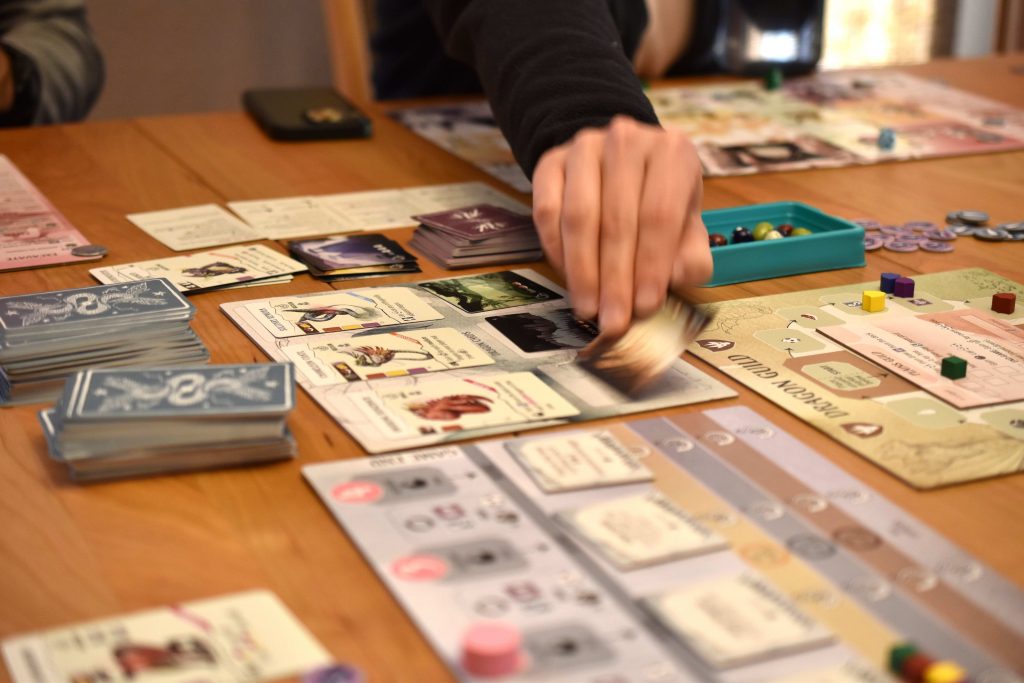
January 11: Exploration, Revisited
I mentioned previously that players use an adventurer meeple to explore their caves from left to right, delving only as far as they have dragons. In today’s post, we’ll discuss a few significant differences between Wyrmspan and Wingspan as related to this left-to-right explore action.
Connie: Wyrmspan leans into the concept of players building out their caves; not only would players be adding dragons to their caves, but they would be shaping the underlying caves as well. In early versions, the cave cards were relatively wide rectangles – the left-hand side of the card would provide some kind of ongoing benefit that would be added to the cave, and the right-hand side of the card would include a space to hold a dragon. The ongoing benefit would be activated each time a player sent their adventurer into that cave.
Ultimately, we found this to be high variance in a way that could make for poor play experiences. As a player, there is almost nothing more frustrating than desperately needing to access a particular resource, and not being able to get it. This didn’t happen often, but when it did, it effectively ruined a player’s game.
In my mind, one of the best innovations of Wingspan is the player mats. The increasing income provided by these mats makes every single bird feel special, and also provides players with a way to access the basic resources that they need to make the game function. With that in mind, we ultimately made the cave mats in Wyrmspan more similar to the player mats in Wingspan – each mat in Wyrmspan has a series of static bonuses on it, so that players can always access the basic items they need in the game (resources, dragon cards, and cave cards).
That said, Wyrmspan uses a left-to-right activation of cards and abilities (the opposite direction from Wingspan). This left-to-right activation proved to be somewhat of a challenge as well; if every space on a mat provided the item associated with that row, then players’ engines quickly got out of control. Wingspan solves this issue by allowing “half-steps” (For instance, take the food row in Wingspan. The first space provides one food. The second space also provides one food – with the option of exchanging a bird card for a second food). A left-to-right activation method made this “half-step” system challenging (both visually and mechanically); so instead, we alternated the row’s primary item with some secondary benefits – specifically, eggs and dragon guild advancements.
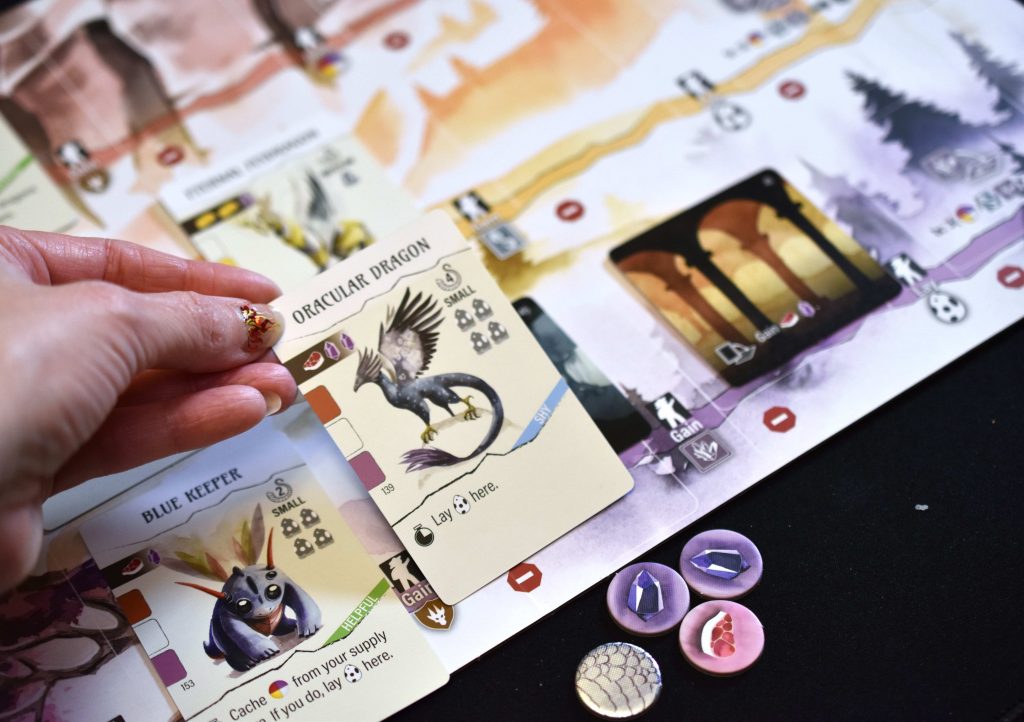
Jamey: One of my favorite twists on the player mats is that each of the 3 caves has a special benefit at the end that you can only gain if the cave is fully excavated and fully occupied by dragons. This gives you a tough decision: Do you diversify, adding a few dragons to each cave and paying only the lowest cost to explore each cave once per round, or do you specialize in a specific cave, piling up multiple benefits and giving yourself access to the end-of-cave explore benefits.
These end-of-cave explore benefits are all geared towards boosting end-game scoring, converting things that don’t normally score into victory points:
- At the end of your Crimson Cavern, your adventurer will find the ability to cache up to 2 resource tokens onto any dragon (up to 2 VP at end of game).
- At the end of your Golden Grotto, your adventure will find the ability to tuck up to 2 dragon cards under a dragon (up to 2 VP at end of game).
- At the end of your Amethyst Abyss, your adventurer will find the ability to discard up to 2 cave cards, then lay 2 eggs per discarded cave card (up to 4 VP at end of game).
Why more points potential in the Abyss? Here’s Connie to explain:
Connie: The purple tunnel is overall weaker. Players in theory want 12 dragon cards over the course of the game (plus tucks) and somewhere around 27 or 28 food (plus caches) but only ever 9 cave cards, the primary benefit of the Abyss (there are a few abilities that discard them, but not as many as tucks/caches).
In playtesting, players built out purple much less than the other 2 tunnels, so made two adjustments – one was heavily slanting the hatchlings toward purple, the other was making the end of tunnel bonus stronger. The other piece of it too is that egg capacity overall is pretty limited, so you can’t really abuse the end of tunnel ability that much. So even if you did nothing but build out purple, it won’t get you very far, since you’d activate it 2 or 3 times then hit your egg capacity.
Jamey: I’ll be back tomorrow for one more design diary post!
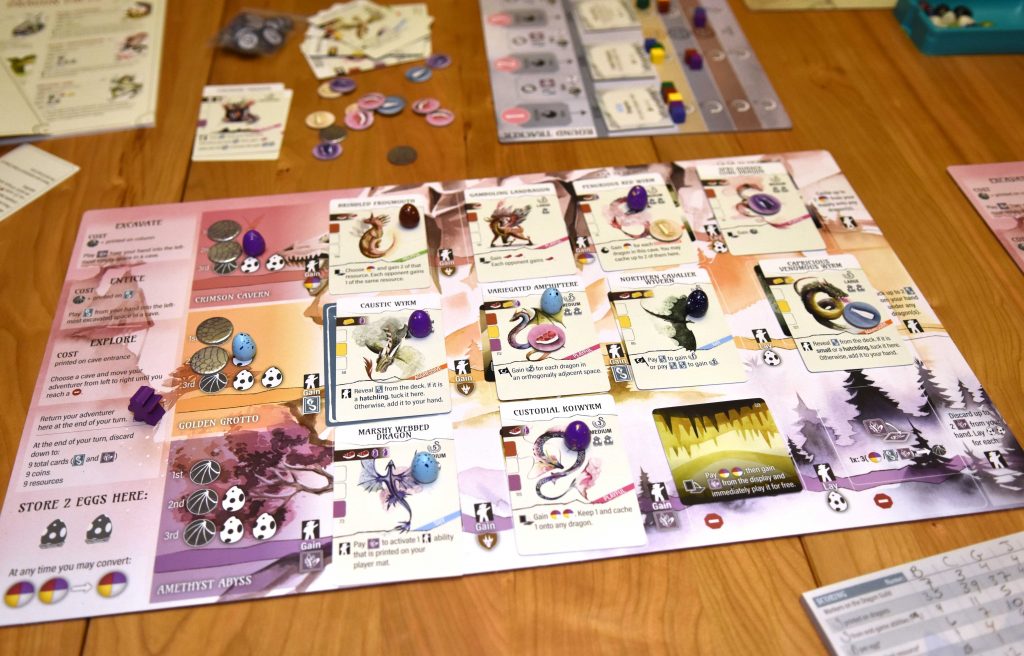
January 10: Automa Solo Mode
Today we have David Studley of Automa Factory to discuss the Automa solo mode in Wyrmspan, the rulebook for which is now available for download (it’s included in the game, along with the Automa cards).
David:
It felt somehow inevitable, yet I had no idea what to expect when I got my first look at the early Wyrmspan prototype. I was thrilled to see that the game had something old, something new, something borrowed, and something… amethyst. For the Automa design, we followed suit by leaning on some tried and true tools, while also trying out some new tricks.
Something Old
Anyone familiar with the Wingspan Automa should recognize the ways we implemented the Automa Approach in Wyrmspan. For example, we handle the objectives exactly as we handled the round-end goals in Wingspan. In providing their results, our amazing playtesters helped establish reasonable ranges that Automa should score for each combination of objective and round.
Based on these ranges, Automa starts the round with a base value for the current objective, which increases or decreases each turn. As when playing against other human players, as the round progresses your understanding of how competitive Automa will be for each objective improves, but you won’t know exactly until she takes her last turn.
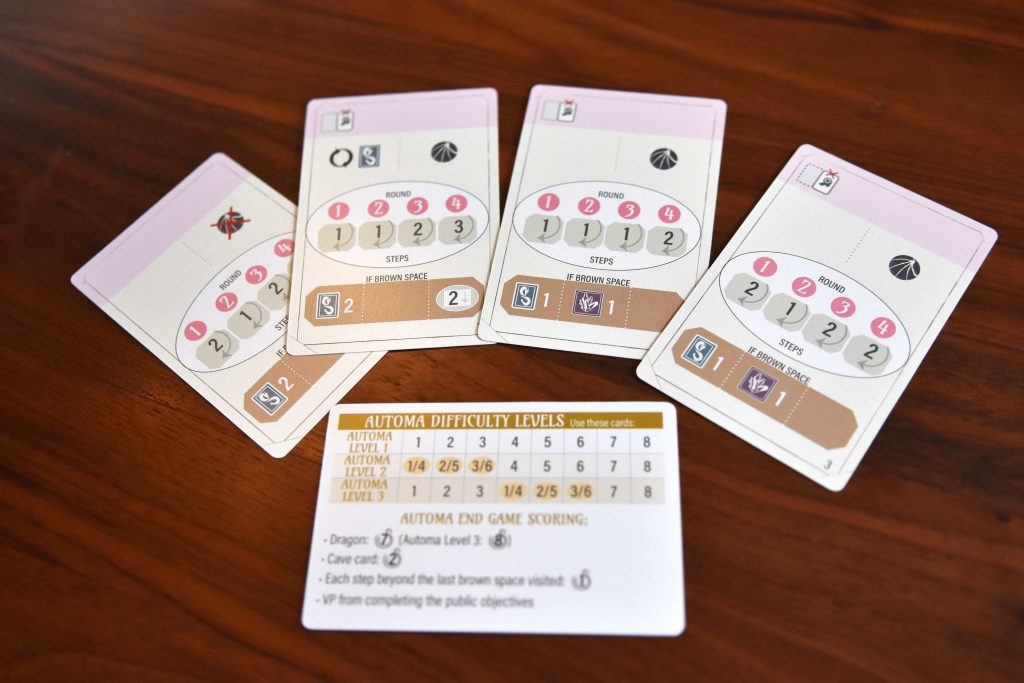
Something New
As you would expect, Automa doesn’t actually build out her own cave mat. Instead, Automa simply moves around the dragon guild track as the main action found on her decision cards, receiving benefits each time she passes the top and bottom spaces of the track. Through that lightweight, breezy mechanism she gains all that she needs to compete with your sanctuary. Along the way we also handle another important point of interaction, as she fiercely vies for those juicy dragon guild benefits. Note: if there’s a specific benefit you want on the dragon guild, you’re going to need to work for it.
Something Borrowed
Equally important to solo play in games like Wyrmspan, is Automa’s responsibility to stand in for other players in keeping the supply of elements (such as the dragons and cave cards) from getting stagnant. Automa must make sure that you cannot count on a card you want being there next turn, and at the same time keep things interesting by making sure that you are occasionally provided with new options. Also, as Wyrmspan is not played over a fixed number of turns, we’ve made sure that Automa’s rounds will vary in length.
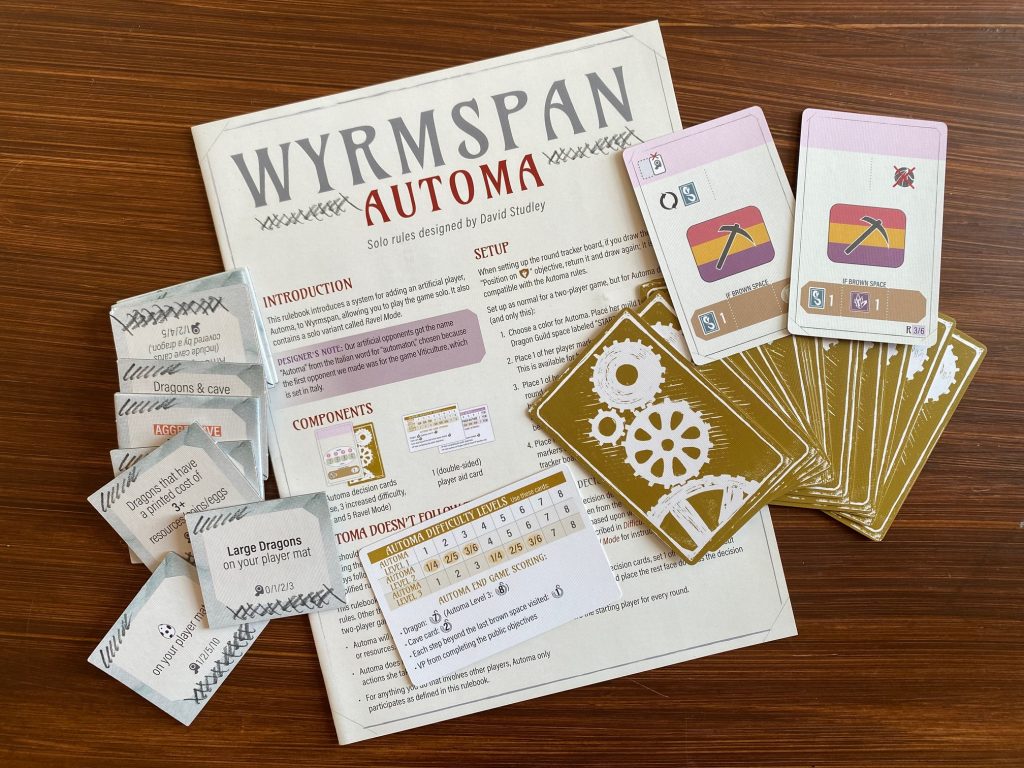
Something… Amythest
One of the solo design concepts I’ve been toying around with is how to make your decisions more impactful on Automa’s scoring potential, without changing the Automa design or straying from the core interactions found in the multiplayer game. The idea is to add an extra bit of puzzliness, without necessarily making it more difficult to beat Automa.
Adding an interaction that doesn’t exist in the multiplayer game deviates from the Automa Approach, so I’m presenting it as variant called Ravel mode. Wyrmspan includes a few cards specifically for this variant. The action on these cards base Automa’s advancement along the dragon guild track on your cave mat, specifically how you have excavated your caves.
This means you’ll want to consider the timing and location as you excavate, as it may subtly but directly impact her scoring potential, both positively and negatively. Ravel Mode is independent of the regular difficulty levels, which are still used when playing with the variant. Instead, Ravel Mode is designed to add a balancing act of little decisions to give you a touch more to think about when you’re in that mood. I’m especially eager to hear your thoughts when you get a chance to try it out.
Thanks for reading. We’re looking forward to chatting with you about the Wyrmspan Automa all over the Internet. On behalf of Morten and the rest of Team Automa, we thank Connie and Jamey for including us on this project. Have fun!
David actively participates in the forums on BoardGameGeek @DJStudley
Jamey: Thanks David! If you would like to read the Automa rulebook, it’s now available for download here: https://shorturl.at/fFKY8
January 9: Accessibility, Dragon Facts, and My Favorite Mechanism
While Wyrmspan is a step up in complexity from Wingspan, we took special care and effort to make the game just as accessible as its predecessor. It helps that everything you need to remember is printed on the player mat and goal board, and we also included the following to help the game get to the table and stay on the table:
- The rulebook is in our new smaller standard size so you can keep it on the table for easy reference. It includes a chart on page 6 of some of the key differences between Wingspan and Wyrmspan, and the last page is an icon guide.
- You can learn the game from the rulebook, the Meeple University rules video (coming on January 22), and/or the free interactive Dized tutorial app.
- Each player has 2 reference cards: One that explains the core actions and how to win, and another that highlights suggestions of what you can do on your first 4 turns (and future turns). It’s a distilled version of Wingspan’s swift-start guides.
- To keep the eggs and tokens from shifting around in the general supply, we included two plastic containers with lids (the same types found in our game Libertalia: Winds of Galecrest). Overall, we tried to keep plastic to a minimum in Wyrmspan, but we thought the inclusion of a few trays would significantly aid the setup, gameplay, and cleanup process.
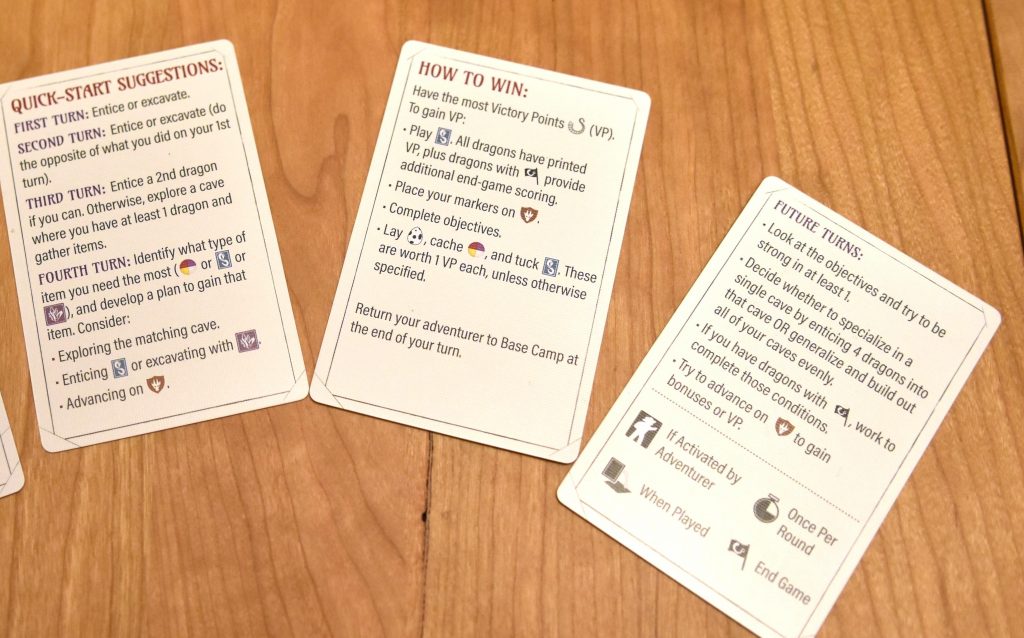
In these design diaries I’ve mentioned a number of differences between Wingspan and Wyrmspan. Here are a few other key differences—subtle but impactful:
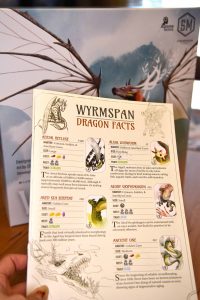 Actions are performed by spending coins and often eggs (not action cubes), both of which you can save for future rounds. There are even some ways to gain extra coins while you play (in Wingspan, you can never gain extra actions).
Actions are performed by spending coins and often eggs (not action cubes), both of which you can save for future rounds. There are even some ways to gain extra coins while you play (in Wingspan, you can never gain extra actions).- There are two nest icons on your cave mat even before you play a dragon (so you can lay eggs on your first turn if you wish).
- No dice (you’re either always gaining a specific resource or your choice of the 4 resources). The food dice are often a nice element of variability and player interaction in Wingspan, but we found it just a little too frustrating in Wyrmspan if all resources weren’t consistently available.
- No bonus cards (these types of bonuses are built into various dragon cards)
- No pink powers (“Once Between Turns”). I like how players can gain things when it’s not their turn in Wingspan, but we’ve noticed that it leads to a lot of questions and confusions among players. Instead, we included “if activated,” “when played,” “end of round,” and “end of game” powers in Wyrmspan.
- A 2-for-1 resource exchange can be used at any time (not just when playing a card)
- Dragon facts are found in a field-guide style book, not on the cards themselves. We found that by separating this text from the cards, we made the dragon cards more vision-friendly (plus, the 32-page full-color book is a fun addition).
Here’s the first of several videos I’m filming about Wyrmspan (including one I’m filming with Connie today about games we recommend if you like Wyrmspan). You’ll also get plenty of videos from content creators on January 22.
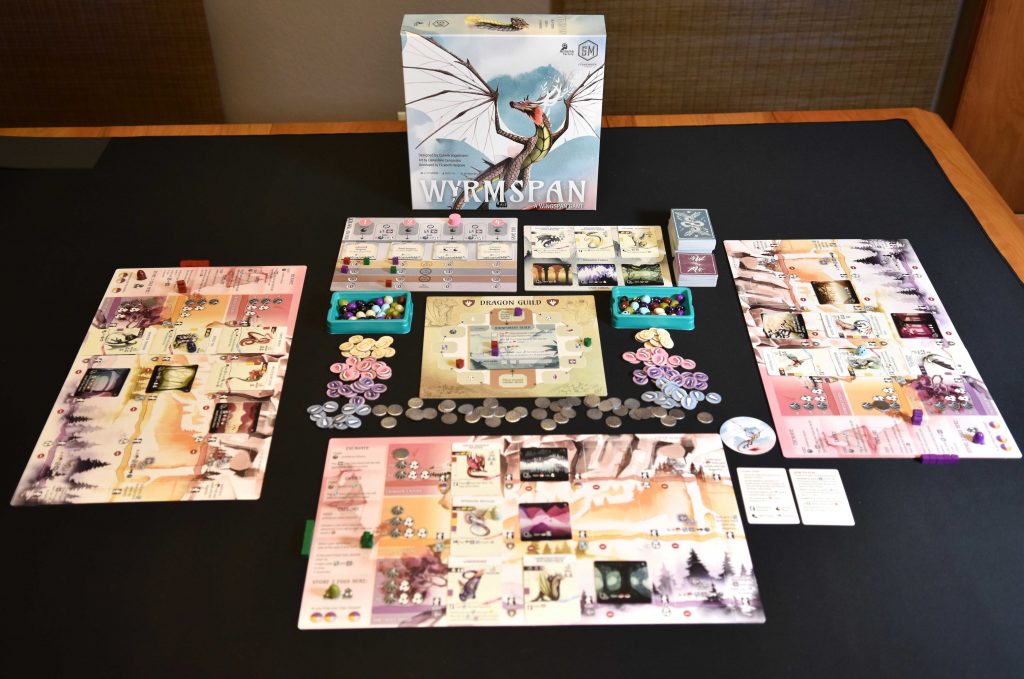
What’s the mechanism in Wyrmspan that you’re the most excited about?
January 8: Guilds, Player Interaction, and Rolling Realms promo
One of the major new mechanical additions focusing on variability and player interaction in Wyrmspan is the dragon guild. During setup, choose 1 of 4 different dragon guilds and place its tile on the dragon guild board. One of the benefits you can earn throughout the game is a dragon guild advancement.
Connie: The dragon guild was added relatively late in the design process, in part to deal with the left-to-right activation problem, described above. This turned out to be a “happy accident,” as the dragon guilds are (for me) one of the most interesting and fun parts of Wyrmspan.
The dragon guild is a circular track, so you can progress around it multiple times per game, and each space on the track provides a different benefit or bonus. In the center of the track is one of 4 unique dragon guild tiles. Whenever you reach the bottom or the top spaces of the track, you can put one of your player markers onto the central tile, and activate a big reward – for instance, playing a dragon for free! However, these spaces are limited, so often become a race with the other players. Adding the dragon guilds helped “spread out” the benefits that you receive from entering one row of your cave – and add a fun source of player interaction and combo-building to Wyrmspan!
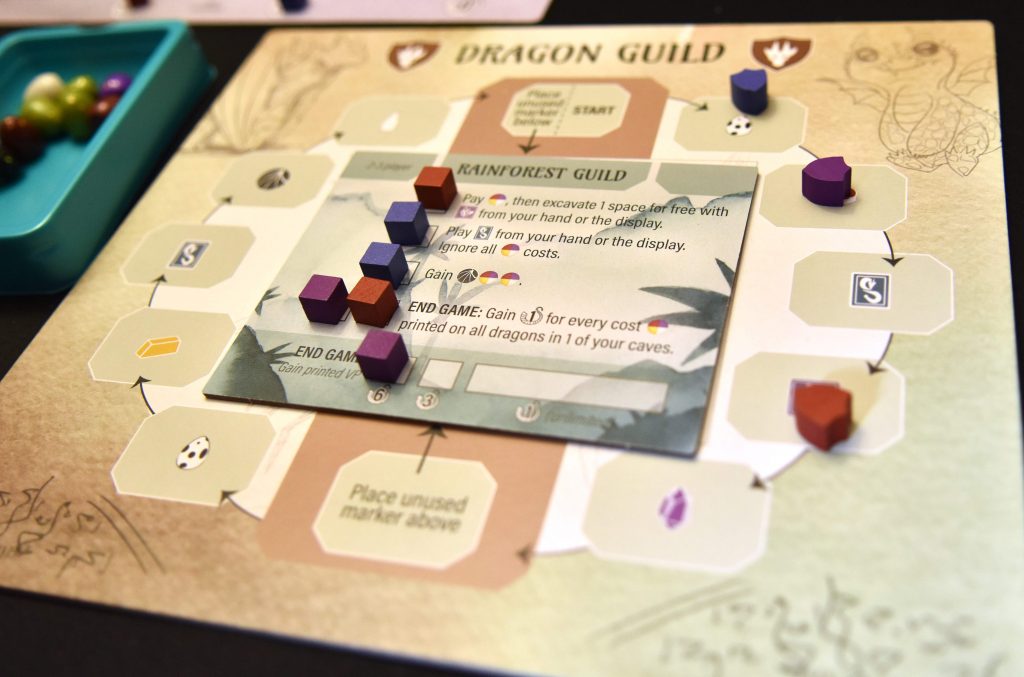
Jamey: One of the goals for the 4 dragon guilds—something that evolved during their design—was to make the special limited benefits on them feel unique to that guild. The Guild of Seafarers cares mostly about dragon cards, the Guild of Highlands cares about cave cards, the Plains Guild focuses on eggs, and the Rainforest Guild focuses on resources.
In terms of player interactions, we pursued a similar vibe to Wingspan in that there are reasons to pay attention to other players, but you’re never attacking or intentionally hurting other players. Imagine a world where dragons of all shapes and sizes are just as common as birds—hopefully our first thought wouldn’t be to use them as vehicles of war.
There are still areas of tension in Wyrmspan, though. The special guild benefits are limited, and they scale by player count (one side of the guild tile is for 2-3 player; the other for 4-5 players). The end-of-round goals are always relative to other players (though ties are friendly). There’s also the tension of claiming available cave and dragon cards before an opponent. And Wyrmspan includes my favorite type of interaction—positive player interaction—via a number of dragon and cave cards that benefit all players.
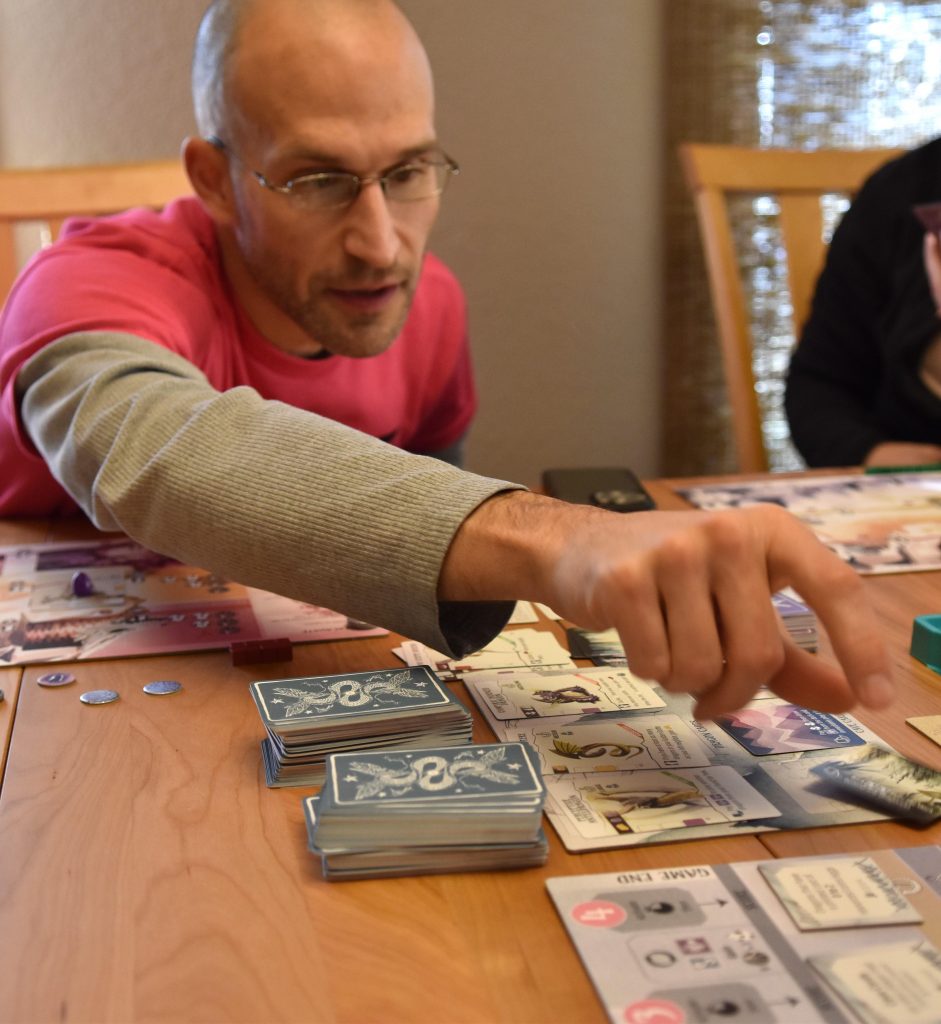
Contrast this to a game like Rolling Realms, in which (by design) there is absolutely no player interaction or reasons to pay attention to other players until you reveal the final score. Of course, we created a promo realm inspired by Wyrmspan, which will be available with 2 other new promos realms (to be revealed later) on January 31.
Which of the 4 guilds best fits where you live or work?

January 7: Exploration, Hatchlings, and the Wyvern disc
The third and final action in Wyrmspan is the Explore action. It’s via this action that you choose 1 of the 3 caves (Crimson Cavern, Golden Grotto, or Amethyst Abyss), pay the cost to enter, and move your adventures through the cave from left to right. Along the way, you’ll gain benefits unique to that cave and the dragons in that cave (if any).
Connie: One of the final elements of Wyrmspan that makes the game sing are the cave entrance costs. Within a round, players can enter the same cave multiple times; however, each time they do so, the cost increases. The first time you enter a tunnel each round, the cost is one coin; the second time, the cost is a coin and an egg; the third time, you must pay a coin and 2 eggs. The concept behind this is that the dragons are getting agitated – the more you disturb them, the more you need to pay for them to let you walk by in peace!
This innovation helped in a few ways – ultimately, we found that playtesters were having more fun with the game whenever they built out several tunnels instead of focusing on one; building out one tunnel and activating it multiple times was sometimes effective, but tended to create a static experience. By increasing the costs each time players entered a cave within a round, players often had more interesting sequencing decisions to make. In addition, by adding eggs to the cave entrance costs, eggs became a special, valuable resources (instead of primarily a source of end-game victory points). Alternating egg bonuses with each row’s specific reward also helped “spread out” the rewards associated with each row, while still making each dragon placement feel special.
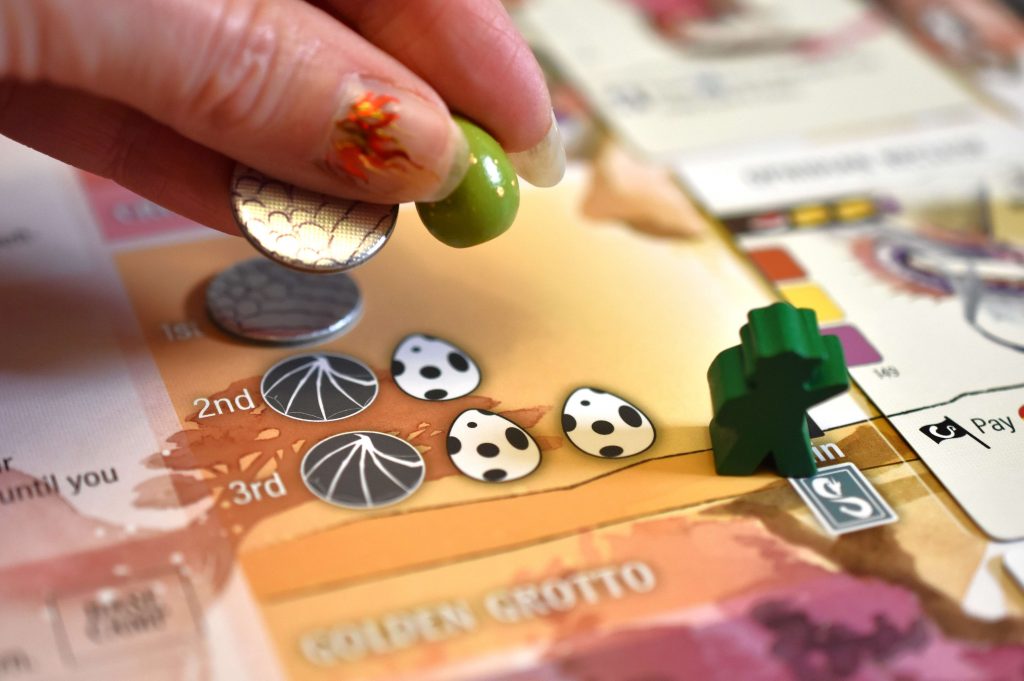
Jamey: I’ll add that when I originally approached Connie about Wyrmspan, a huge priority for me was adding a sense of theme to what you’re doing when you activate a row of cards. I love the feeling of gaining the core benefit of a habitat in Wingspan and then activating birds from right to left, but I can’t thematically describe exactly what I’m doing.
That’s the thematic reason you have an adventurer meeple in Wyrmspan and why you explore from left to right. You’re walking through your cave, checking in on the dragons in your care.
Connie: Early on, Jamey had the idea to include hatchlings. The concept behind the hatchlings was that they would have a voracious appetite (in terms of requiring food or other resources!), but that players would be trying to help the hatchlings “grow up.” The hatchlings quickly became one of my favorite parts of the game – each hatchling has some kind of an ongoing ability that you trigger throughout the game (generally, you must give it food or a card to gain a benefit). However, when you activate the hatchling a third time, the hatchling “grows up,” and gives you an extra special reward for giving it so many resources! Hatchlings are expensive, but can provide major rewards, if you can time them correctly.
Jamey: From the adorable art to the sense of progression within the cards, I absolutely love how the hatchlings turned out. There are 35 total hatchlings in the game, and each requires at least 1 egg and 1 milk to play. This is a big request we heard about Wingspan over the years: You have these eggs, so why not have something hatch from them?
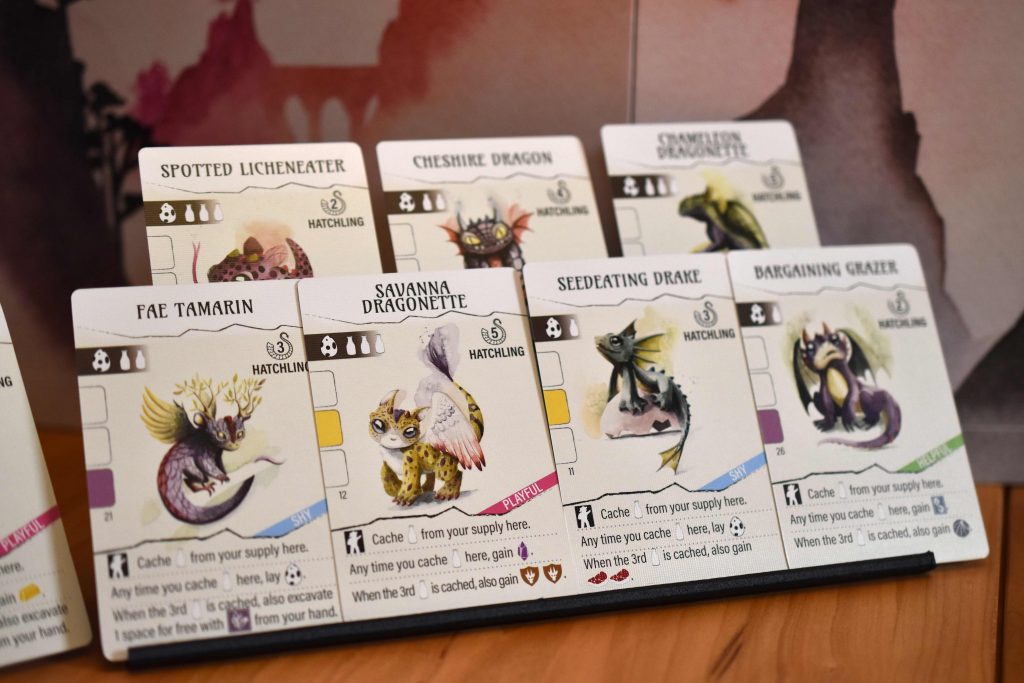
If you have a few minutes, I’d highly recommend reading this article by Wyrmspan artist Clementine (@blule), especially the part about her inspiration for the hatchling paintings: https://blule.fr/blogs/blablabla/watercolour-wings-reimagining-dragons-for-wyrmspan
Clementine also hosted an AMA (ask me anything) yesterday on BoardGameGeek: https://boardgamegeek.com/thread/3221587/wyrmspan-artist-ama
As did Connie! https://boardgamegeek.com/thread/3221490/article/43570798
Also, as has become tradition with new Stonemaier releases, we worked with Innova and artist Miles Bensky to create a new custom disc golf disc specifically for Wyrmspan. It’s called the Wyvern, and it will be on our webstores on January 31 along with the Wyrmspan game.
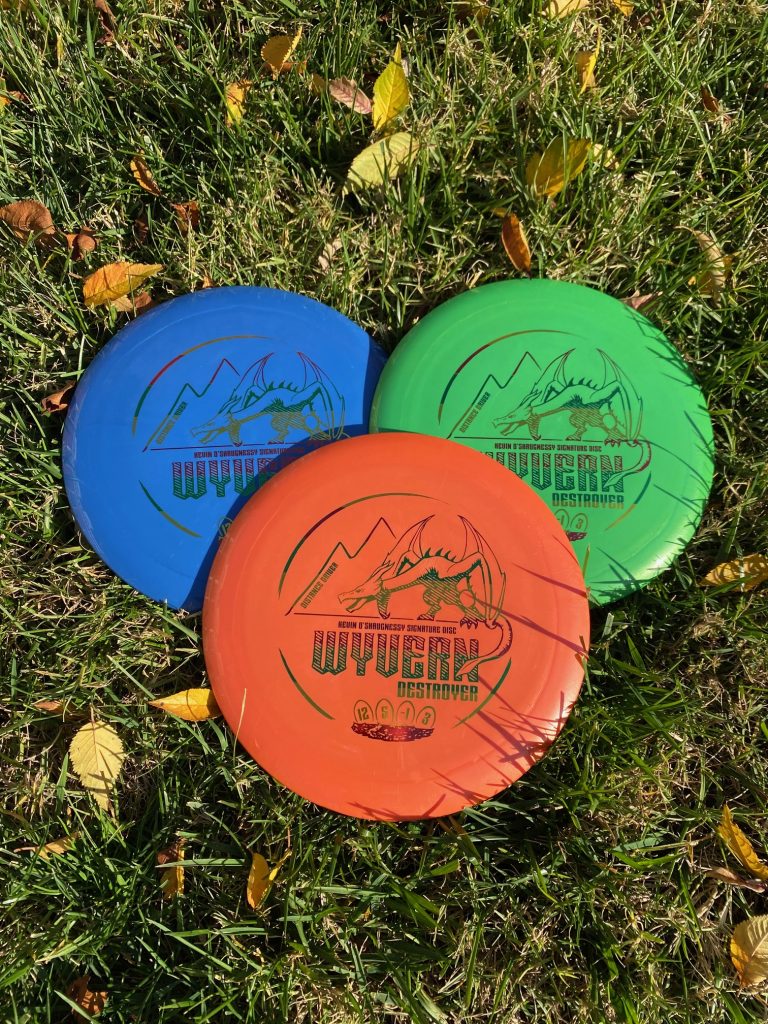
What do you think about the new hatchling mechanism?
January 6: Enticing Dragons, Traits, and Components
As dragon lovers and researchers, players in Wyrmspan aren’t capturing, trapping, or imprisoning dragons. Rather, they’re building homes for them (excavating caves), then enticing dragons into those homes via their favorite treats.
Entice is the second core action in Wyrmspan; with 12 spaces for dragons on your player mat, you can potentially Entice a total of 12 times over the four rounds of a game. Just like all other actions, you must pay a coin, then play a dragon card from your hand into the leftmost excavated space of a cave matching that dragon’s preferences (some dragons prefer some of the 3 caves over others; this is shown on the left of each dragon card).
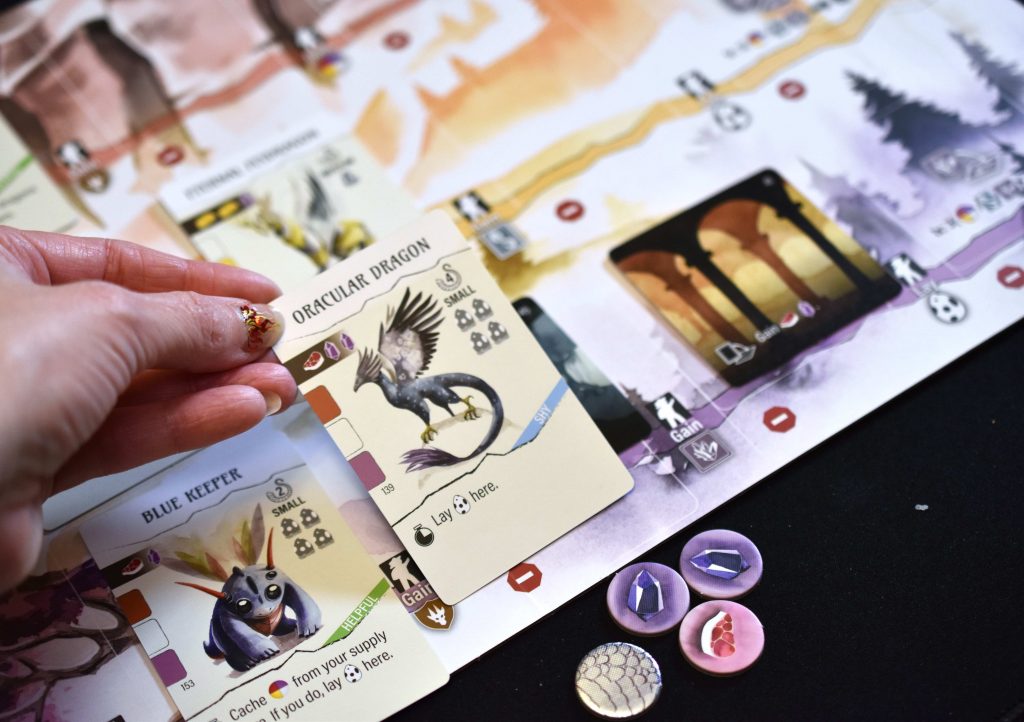
We designed the combination of dragon cards and cave mats to show that when a dragon is played, it extends the reach of your adventurer meeple (which you’ll use for the Explore action). You can see that the dragon covers the red “stop sign” while continuing the path into the cave. So every dragon you play gives you access to more Explore benefits in addition to the unique benefits printed on the dragon card itself.
The Entice action is very similar to the Play a Bird action in Wingspan, but with two notable exceptions: There’s no egg cost for specific columns (this cost is limited to excavating) and you can use a 2:1 resource conversion at any time, not just while playing a dragon.
Wyrmspan features 183 different dragon cards in addition to the 75 cave cards I talked about yesterday. Another new element on these dragons is that we gave each of them a personality trait: aggressive, helpful, playful, and shy. These are referenced by some cards and round-end goals, and they add a little thematic connections, a reminder that animals are wonderful, peculiar creatures. One is even inspired by my cat, Walter (and my beloved Biddy, who passed away last year):
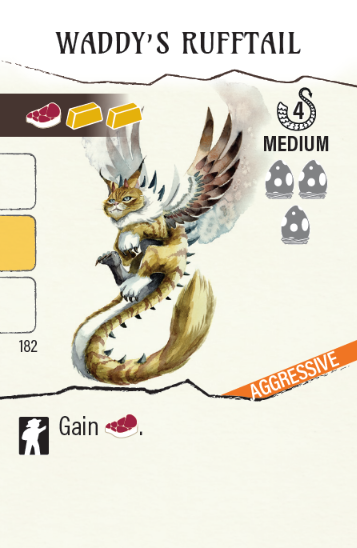
Beyond the dragon cards, there are several other components designed to make every copy of Wyrmspan feel special: The cardboard coins have a special foil coating, and all 55 wooden eggs are painted in several dragon-themed colors (including speckling on every egg). Panda sent us dozens of samples of various base/speckled combinations. My favorite is the Yoshi-inspired white and green egg.
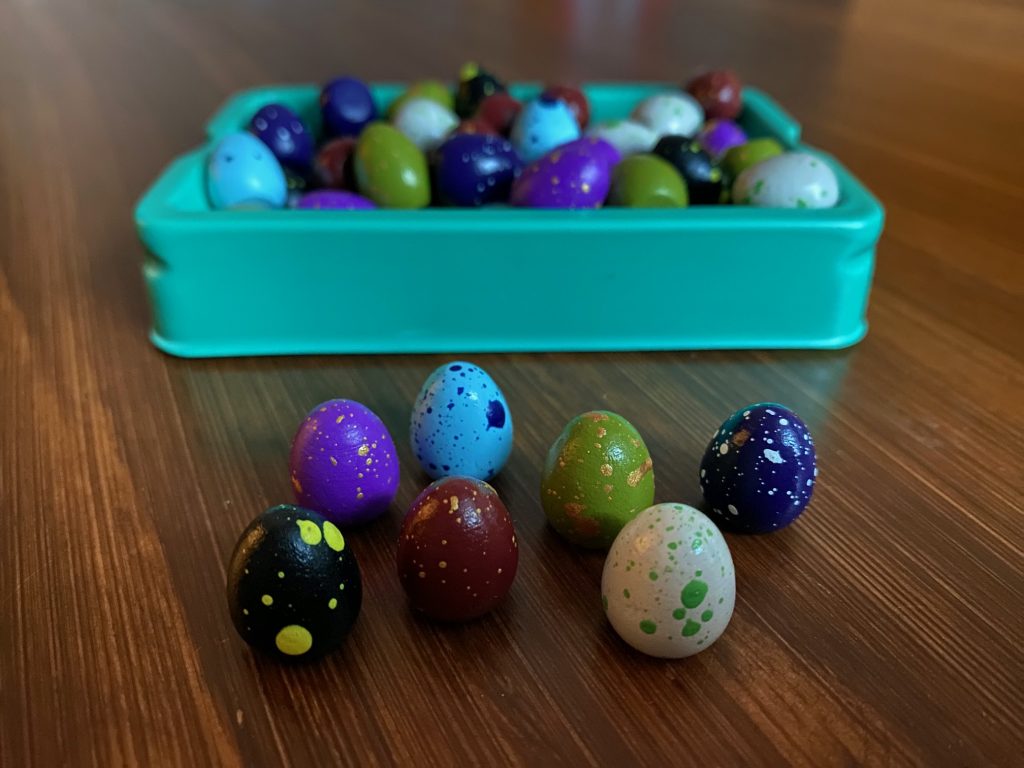
In that way, every copy of Wyrmspan is designed to feel premium while being priced similarly to Wingspan. However, if you want to get extra fancy, we also made natural rubber playmats and component upgrade packs (a combination of wooden resources and metal coins). They’ll be available as add-ons when Wyrmspan launches on January 31 on our webstore.
I’ll be back tomorrow to talk about my favorite type of dragon: hatchlings!
Which dragon trait fits you best?
Also today, check out this video showing the similarities (and many differences) between Wingspan and Wyrmspan:
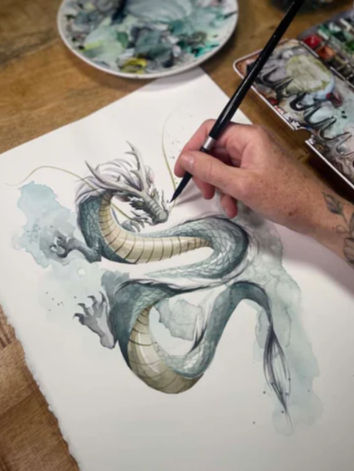
Bonus: Watercolour Wings: Re-imagining Dragons for Wyrmspan
by Clementine Campardou
I’ve been blessed with many amazing opportunities over my years as an artist, and every time it was all about communities, about people. This is one of those stories.
For the past year and a half, I’ve been working with a small team of truly wonderful people, taking on a tough challenge: re-imagining what is now a classic of the board games scene—Wingspan by Stonemaier Games—and create the art for their new game: Wyrmspan.
Creating a whole new game, while remaining faithful to the foundation laid out by the original one. Being new enough, and familiar enough at the same time.
continue reading on Clementine’s website
January 5: Core Mechanisms, Caves, and Art
We wanted Wyrmspan to be familiar to those who know Wingspan, so the core hook of Wyrmspan is the same: You’re collecting a variety of winged creatures by playing them on your mat in such a way that they improve your 3 action rows both by default and by dragon powers (with each dragon also offering a when played, if activated, end-of-round, or end-game power). Your player mat also evolves with cached resources, tucked cards, and eggs.
Beyond that core concept, Connie innovated every other aspect of the game. The changes range from small tweaks to entirely new mechanisms. The result is an increase in complexity, while still keeping accessibility in mind.
Connie: The core system in Wyrmspan will feel very similar to those who know and love Wingspan, Wyrmspan is a more complex game (at least compared to Wingspan without its expansions). It aims to keep the richness of the tableau building in Wingspan, while introducing new considerations, including building out your cave, growing your hatchlings, and advancing on the dragon guild.
I’m excited for players to discover Wyrmspan, and all that the game has to offer. I hope that Wyrmspan achieves what it sets out to do – that is – be a worthy homage to its predecessor, while still creating a unique and original gameplay experience.
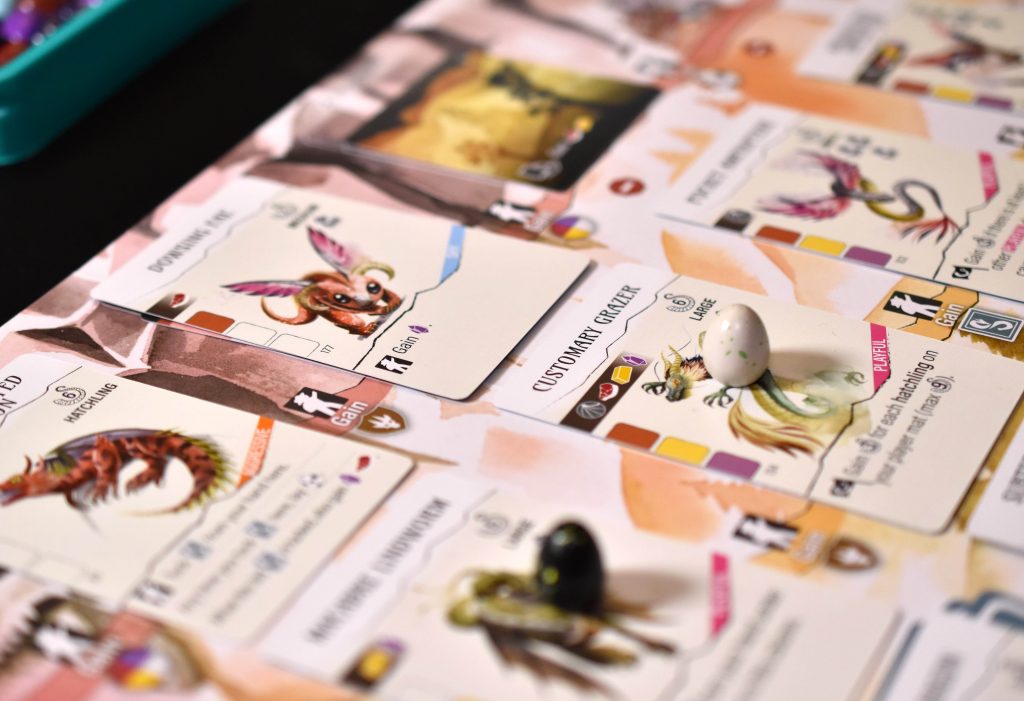
Jamey: One of the new mechanisms is both a new action (Excavate) and a new type of card (cave).
Each player’s player mat has 12 spaces for dragon cards, and the leftmost space of each cave is already excavated. The idea is that you have a few cave systems on your land, but you haven’t delved deep into any of them. To make them habitable for dragons, you must first excavate each of the 9 other spaces.
The cost to perform an Excavate action is 1 coin (close to the equivalent of an action cube in Wingspan), plus either 1 or 2 eggs if you’re excavating a space in the rightmost columns. You excavate from left to right using a cave card in your hand, and every cave card has a “when played” benefit.
At one point we experimented with cave cards having “when covered” benefits (when you play a dragon on top of them), but it made Excavate turn benefits seem too small and Entice turns too big. We did keep one type of “when covered” benefit, though it’s printed on the far right space of each player mat, not on a card. When you excavate that space, you can pay any 3 resources to gain a coin (essentially an extra action—super powerful!).
I love the addition of the cave cards, as it feels like I’m building a home for my dragons. It helps that the art from Clementine Campardou is stunning—the caves have this beautiful, otherworldly, side-scrolling look to them. You can find Clementine’s art here: https://blule.fr/collections/dragons
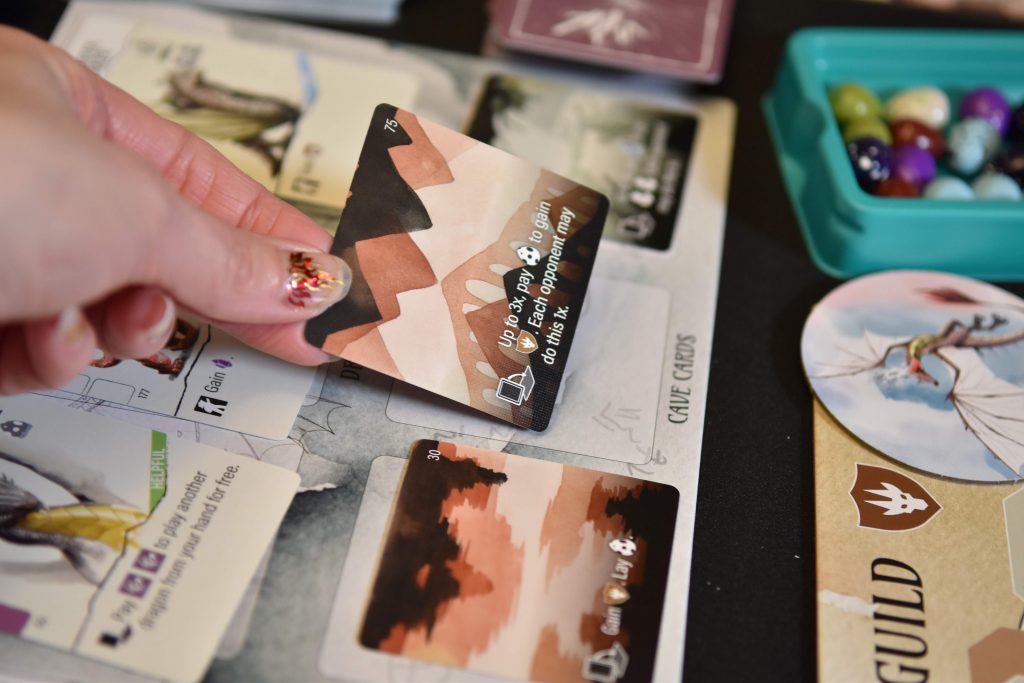
Connie: Clementine was involved with the project from the very beginning, and was contributing gorgeous and creative dragons throughout. Her creativity and vision informed the abilities and traits that each dragon had, and their abilities in turn informed the art. Being able to have that back-and-forth with her was an incredible experience, and it contributed significantly to the richness of the game and its storytelling. This was particularly consequential toward the end of the design process – where we had a very specific set of dragons, abilities, and personality traits that needed to be included in the game – Clémentine was able to bring these to life. I continue to be amazed by the creativity, variety, and charm of the dragons that she created for Wyrmspan.
Jamey: I’ll be back tomorrow with more stories and reveals!
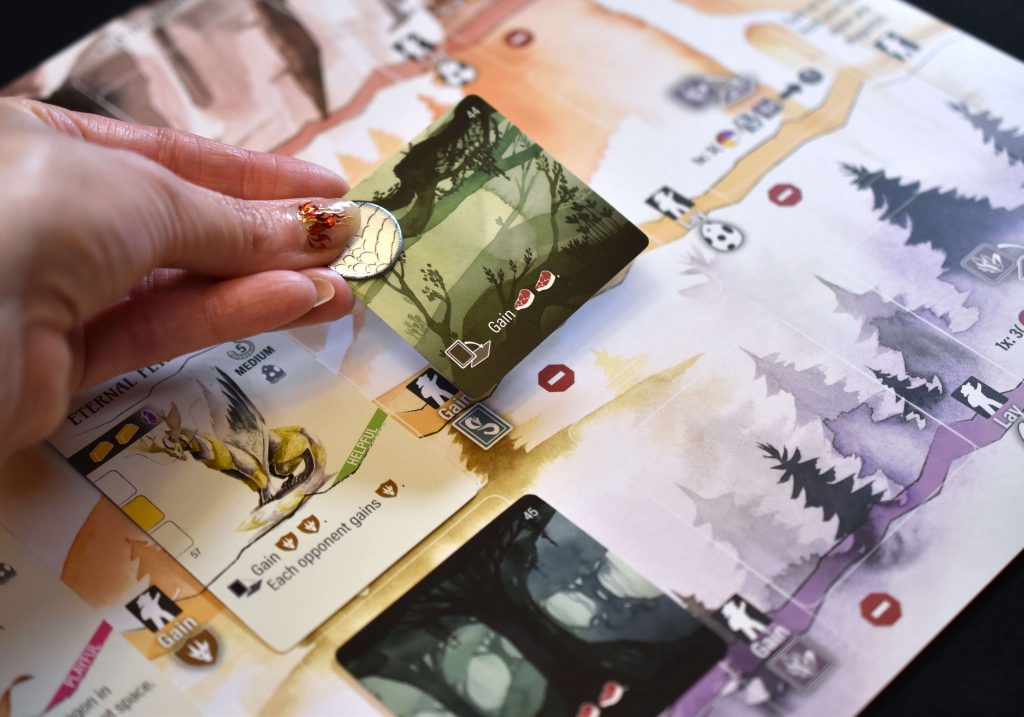
January 4: Wyrmspan’s Origin Story
I love learning the origin stories for ideas and the early stages of projects, and fortunately Wyrmspan designer Connie Vogelmann has documented some of those anecdotes for us.
Wyrmspan started as an internal discussion (plus Elizabeth Hargrave) about what could be next for the wider world of Wingspan. Our sense was that there was potential and desire for themes other than birds, but we didn’t want to just reskin Wingspan with a different animal. Rather, we wanted to create something new-yet-familiar that appealed both to Wingspanners and those who wanted something different and a little more complex, within the context of a new theme. We debated back and forth between dinosaurs and dragons, and we ultimately decided on dragons (which was, coincidentally, the theme for a prototype a friend worked on under the working title Wingspan years ago before we ultimately moved forward with Elizabeth’s Wingspan, originally called Bring in the Birds).
Elizabeth was very busy with The Fox Experiment and Undergrove (along with Wingspan expansions), so we asked for her blessing for another designer to handle the Wingspan spinoff, with Elizabeth serving as a developer (someone who helps a game be as fun, functional, balanced, and intuitive as possible).
I had a fantastic experience working with Connie Vogelmann on Apiary, so she came to mind first. Connie is an extremely talented designer, and she’s also very dedicated to playtesting, an excellent communicator, and she works and iterates quickly. It also happens that Connie and Elizabeth are local to each other. So I reached out to Connie to see if she might be interested in creating a proposal for Wyrmspan to run by Elizabeth for approval.
Connie: The question triggered a set of conflicting emotions: on the one hand, this type of opportunity is a designer’s dream – getting the chance to make a spinoff of one of the most successful euro games of the last decade is almost certainly a once-in-a-lifetime opportunity. Elizabeth had been a mentor to me, and being able to work directly with her (and continue to work with Jamey!) was incredibly appealing. Plus, I had long loved Wingspan; the underlying game system is brilliant, and having the opportunity to put my own spin on the system was exciting!
On the other hand, there was the imposter syndrome: my first game wasn’t even done yet – did I have the design chops to do the Wingspan “brand” justice? Was I the best candidate to design a game about dragons? I grew up reading Ann McCaffrey’s Dragonriders of Pern series, but I would hardly call myself a certified dracologist. And finally, I was well aware that taking on the project – if it came to fruition – would put me relatively in the public eye (for a game designer!), in a way that I was, frankly, uncomfortable with. Any spinoff of such a popular game, no matter how well conceptualized or how well-executed, was going to come with a lot of baggage, both good and ill.
Ultimately, the former considerations far outweighed the latter, and the rest is history. Jamey and I brainstormed an outline for Wyrmspan over the subsequent weeks and pitched it to Elizabeth. With her blessing, we were off to the races!
Jamey: Before we continue, I want to remind you that if you want to see exactly what Wyrmspan ended up being, the rulebook is available here: https://shorturl.at/fFKY8 We’ll delve into each of the mechanisms—including what’s different between Wingspan and Wyrmspan—in upcoming posts, but today Connie will share a deep dive into mechanisms she explored that didn’t work out for various reasons.
Connie: Early drafts of Wyrmspan had some elements that made it through to the final game – including the idea of building out a cave and the concept of “hatchlings” (baby dragons with voracious appetites!) – but there were several other core elements that were present in the early drafts that fell by the wayside fairly early on, including:
Vertical Movement: Initial drafts of Wyrmspan envisioned a fluid version of cave exploration, in which players had an adventurer that was able to twist and turn throughout a player’s cave network. Some of the earliest drafts of the game had tunnels extending in all directions from a central cavern, with your adventurer picking a direction, and exploring throughout a series of horizontal (and vertical) steps.
This was conceptually interesting, but somewhat clunky in practice – it was hard to develop a ruleset for movement that was simple, that felt thematic, and that avoided any possibility of an infinite loop.
This system also lost the “identity” of the tunnels – each row of a player mat in Wingspan is associated with a particular type of item. By making movement fluid, that identity is lost, and becomes much more dependent on the individual cards that players place into their tableaus. What this meant in practice was that either players placed just a few dragons – then activated those dragons every single turn, or were unable to find dragons that provided certain key resources, meaning their game ground to a halt (while others’ engines got off to a roaring start).
Ultimately, as interesting as vertical movement was, we ultimately cut it fairly early on, and instead focused on building a more streamlined tunnel system that was much closer to that of its predecessor.
Bag Building: The first several versions of Wyrmspan used bag building to determine what actions players could take. Players could draw fire cubes and ash cubes out of their bags, and could continue to explore their caves until they either ran out of fire cubes, or drew a certain number of ash cubes. At this point, their torch would go out, and their turn was over.
Early versions of the game also incorporated differentiated costs to move through your cave – e.g. some spaces in your cave would cost one fire cube to bypass, whereas others would cost two or even three. In general, placing dragons in your tunnel decreased the total cost that you needed to pay to walk by that space – so the more dragons you played, the farther your could explore. Some dragons also had “Halt” abilities – essentially, a mandatory toll. By choosing to walk over that dragon, you were required to pay an extra fire cube (or other resource) before that dragon would let you pass.
This system was intellectually interesting, but often wasn’t fun. By adding a “push-your-luck” element, players had drastically different turns. Even if it all evened out by the end of the game, an early round where one player got a small turn and another got a huge one often left a sour taste in the unlucky player’s mouth, spoiling the overall experience.
Adding a bag building element also effectively “doubled” the engine building of the game – players were simultaneously building two engines: their bags and their caves. This oftentimes led to fun decisions on an individual level, but made the game incredibly swingy. A good early turn could compound exponentially, often giving one player an insurmountable lead from one of the first turns of the game.
Finally, bag building was complex, and punishing. Although Wyrmspan was always intended to be a little bit more complex than Wingspan (at least the base version), adding an entirely new, complicated, mechanism on top of already rich tableau-building experience ended up ratcheting up the complexity too much. It also ended up making the game feel fairly punishing; if a player failed to suitably improve their bag, they quickly fell behind. Especially for a game that is intended to be enjoyed by families, this felt like a potential misstep.
In a lot of ways, Wyrmspan’s final action selection system is fairly similar to that of Wingspan – both games essentially use “action points” that players spend each round to take actions. That being said, some influence from the bag building system remains in the final version of Wyrmspan; for instance, not all actions in Wyrmspan cost one action “point” (represented as coins), and some dragons and abilities give you coins during the round. This means that, although you are no longer building a bag, there is an important action efficiency element of Wyrmspan, which can make each round more variable than those in Wingspan.
| This early cave mat (from February of 2022) had vertical movement – the blue “squiggles” between the rows represented walls, with the gaps representing a place where your adventurer could jump from one row to another. The boxes in the lower right-hand space represented the “cost” (in fire cubes) that a player must pay to walk by each spot in their cave. |
Market: In part because of the complexities associated with bag building, early versions of Wyrmspan had a market; on your turn, you either explored your cave, or went to the market, where you could gather resources or cards. Ultimately, although going to the market makes thematic sense (if you’re an explorer venturing deep into a cave, it is logical that you would need to prepare for that adventure), it made for some boring turns. It also made for an uneven gameplay experience – players were alternating between boring (market) turns and the much longer, more exciting exploration turns, making gameplay feel disjointed. After the bag building disappeared, the market soon followed, and all actions were folded into cave exploration.
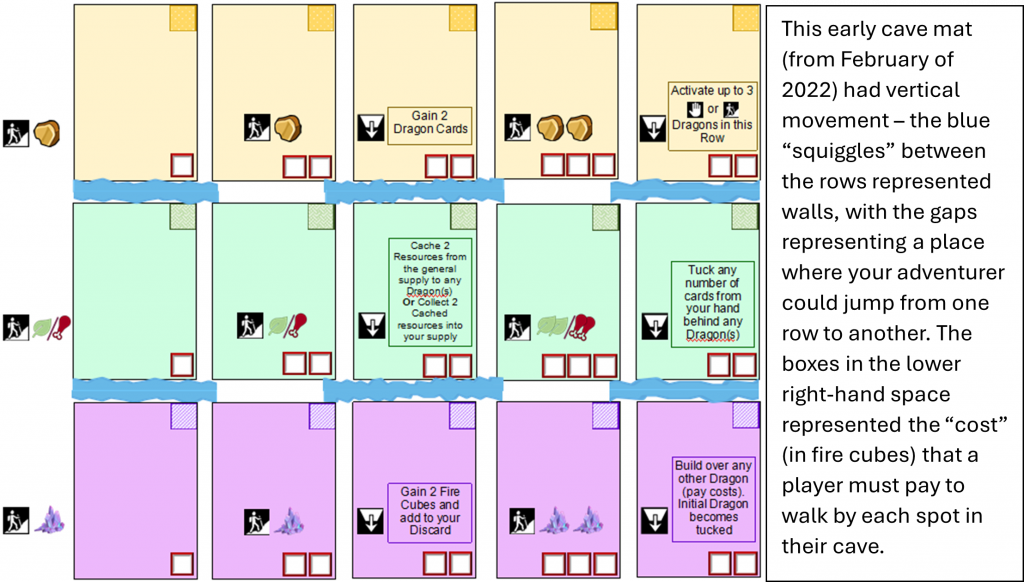

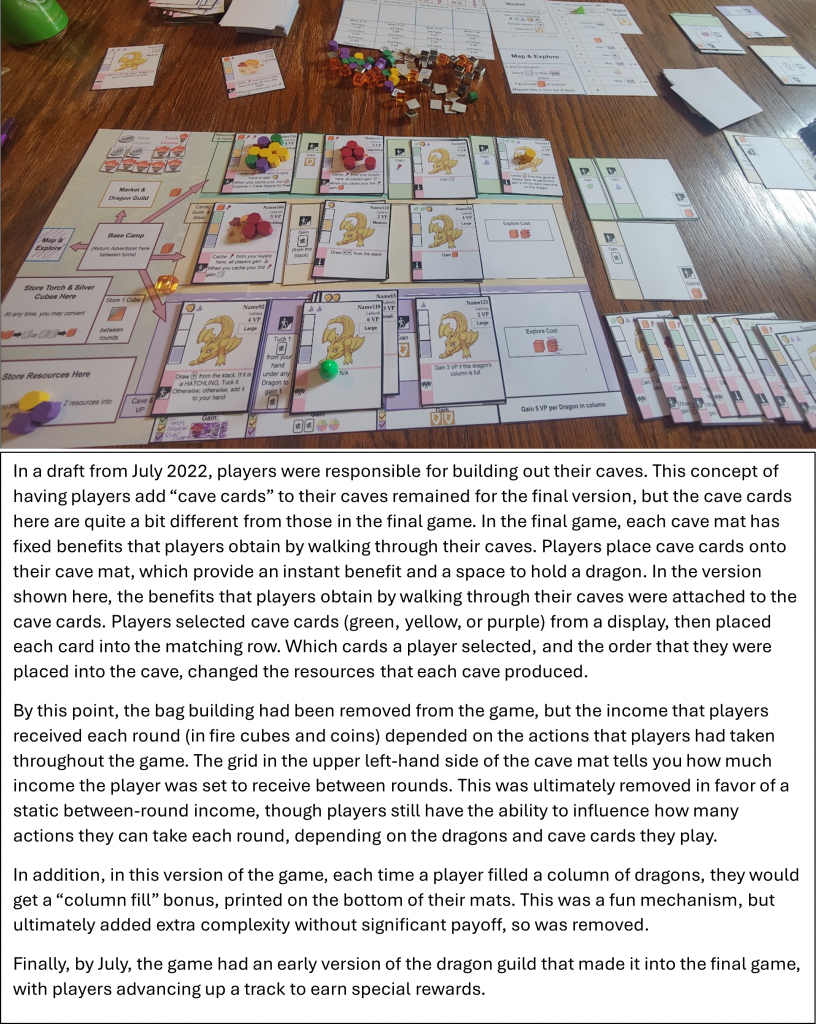
Jamey: We’ll be back tomorrow to talk about the core mechanisms in Wyrmspan. For now, if you’d like a little taste of them, check out this video:
January 3: Teaser Trailer, the Box, and Launch Signups
I’m so excited to reveal another game from Apiary designer Connie Vogelmann, Wyrmspan!
Wyrmspan is a 1-5 player, medium-heavy weight, competitive engine/tableau-building game that plays in around 90 minutes. Wyrmspan is inspired by the mechanisms of Wingspan, though its many unique elements make Wyrmspan a standalone game (not compatible with Wingspan). Wingspan designer Elizabeth Hargrave supported the development of Wyrmspan with her time, insights, and playtests.
I’ll discuss these actions and the evolution of the game over the next 8 days, but if you want to “spoil” how the game works, the full rulebook is available right now. Today we’re also revealing the box, which—along with all components in Wyrmspan—is illustrated by Clementine Campardou. The box size is 296x296x70mm, and it weighs 2.6 kg.
Wyrmspan is set to launch on our webstore on January 31, shipping to customers throughout February from fulfillment centers in the US, Canada, Europe, and Australia. You can sign up here for a launch notification and other updates for Wyrmspan and the broader world of Wingspan: http://eepurl.com/iEYmAw
Localization partners for Wyrmspan include Grok Games (Portuguese – Brazil), Surfin’ Meeple (Chinese), Mindok (Czech), Matagot (French), Feuerland (German), Ghenos (Italian), 999 Games (Dutch), Divercentro (Portuguese), Troy Games (Turkish), and Maldito (Spanish); if you want this game in another language, please contact your local publisher of choice to express your interest.
Today is also the debut of the teaser trailer for Wyrmspan, featuring a voiceover by Megan Selke, video editing by JC Trombley, and music by Joel Winbigler. Feel free to share it with your favorite Wingspan-loving friend!
Also, big thanks to photographer Carol Johnson (Carol@PatchesPictures.com), whose photos you’ll see throughout these design diaries.
8 Comments on “Design Diary”
Leave a CommentCancel reply
If you ask a question about a specific card or ability, please type the exact text in your comment to help facilitate a speedy and precise answer.
Your comment may take a few minutes to publish. Antagonistic, rude, or degrading comments will be removed. Thank you.
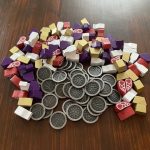
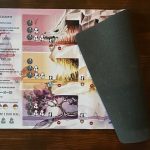
I really love how Jamey calls some of the production decisions, “small quality of life things.” That has HUGE implications. Enjoying this hobby is a major contributor to my quality of life :) Every small decision to maximize that experience is compounded many times over during those precious few hours I’m sitting at the table playing. Thank you, Jamey and team!
Thanks! That’s a great point that small decisions can make a big impact. :)
Waddy’s Rufftail is awesome. Love the tribute. Those eggs definitely have a mystical dragon feel to them.
Funny you say that Ian, I had come here to actually say the opposite, I don’t like seeing tribute cards in games. (I think Mark Rosewater has said somewhere that Magic the Gathering used to do them but doesn’t anymore, and I think it’s a good choice not to). I totally get the love and respect for animals. I have a rabbit and I love him, but would hesitate sneaking him into a game. Reason being is that once any kind of art (be it music, literature, games etc) goes out into the world, it no longer belongs to the creator but to the audience. I don’t like cats, and when I buy a game the last thing I want to see is someone’s cat in it. (Had this experience with Apiary–love the game, but was a bit annoyed when I saw a cat snuck onboard the beeship.) There are plenty of games about cats out there for people who like cats. Sorry if this comment is disresepctful in any way, I’m sure it will be unpopular, but as someone who is very public with their learnings Jamey I though you’d appreciate the honesty. Sorry to hear about Biddy. I’ve lost pets before and understand how treasured they are. All the best with the game, it looks terrific.
Part of running a game company is having fun with it, and a big part of my joy is including Easter Eggs in our games. https://stonemaiergames.com/all-easter-eggs-of-biddy-and-why-they-matter/
Keep those Easter eggs coming! Even if I wasn’t a cat lover, I can appreciate that it brings you joy and that’s what this hobby is all about! I’m really looking forward to Wyrmspan and I’m glad Biddy lives on even in this game too! So sorry for your loss — I’ll miss his cameo appearances in your videos too.
Thank you, Christi–I appreciate that. :) I miss Biddy too.
I’m really liking the actions you take in this. Definitely a ramped up Wingspan.